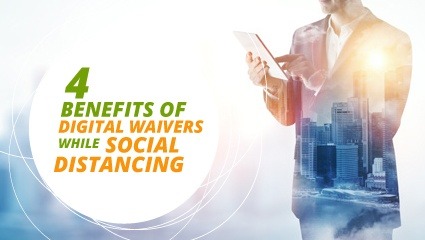Blog
Four Benefits of Digital Waivers While Social Distancing
May 15, 2020 / 7 minute read / By Robert Josefs

Blog

By Daryl McCarl, Director of Business Development at Smartwaiver.
Businesses across the globe have been significantly impacted by unprecedented events brought on by COVID-19. While retailers are desperately working to shift their sales strategies to remain profitable during the pandemic, other businesses have not been so lucky. If your business relies heavily on revenue from events and activities, social distancing and shelter-in-place guidelines have not been kind to you. Fear not though! There’s still quite a bit you can do to remain productive during this downtime.
Many event- and activity-based businesses have some sort of release of liability waiver in place to keep participants safe and to avoid unnecessary lawsuits. Because operations are largely shifting to the online space, some of these businesses have started implementing digital liability waivers for further convenience and security. If that’s where your business falls, you’re in luck! Here at Smartwaiver, we know digital waivers can be one of the most beneficial tools for sustaining your business — especially during this time of social distancing.
But how can a digital liability waiver benefit you now? What can you do with all the data that you collect?
Every individual that visits your business or participates in your activities comes in with their own personal histories, and a unique set of demographic, psychographic, geographic, and behavioral characteristics that define who they are. Having access to such insightful information is a huge step towards better understanding your target audience.
Imagine two different customers— Angie and Marcus:
While Angie and Marcus are both valuable customers, the way you communicate and relate to them should be significantly different. Since Angie is a regular customer, it’s important to let her know you appreciate her frequent visits. Marcus, on the other hand, is a short-term tourist who will likely return home soon after his visit. Still, it’s a good idea to keep in touch to remind him of the great time he had in case he ever visits again; or to encourage him to share his experience with friends and family who may visit the area!
But how can you keep track of all this information? Do you have to manually record details you pick up on each customer and use that to inform your messaging strategy? That’s where digital liability waivers come in. Every time a customer fills out a waiver, they provide you with certain basic information (i.e., name, age, date of birth, address). Plus, you can customize your waivers to get more data— although you don’t want to overwhelm the user. Armed with this information, you can divide customers into segments (or categories) of similar individuals; and greatly improve your marketing strategy by creating more effective messages that appeal to them.
After segmenting your target audience, it’s time to decide what to do with that valuable data that can be collected from your digital liability waiver. One of the best ways to use consumer data is to implement personalized email outreach. Did you know 99% of consumers check their email at least once per day? Whether you have an email marketing strategy or eager to get started, here are some important tips to keep in mind:
Not only will personally-crafted emails grab the attention of your audience, they can help to build positive customer relationships during the off-season. There’s a better chance they will visit your business in the future!
Another best practice to keep in mind throughout the COVID-19 pandemic, and beyond, is to monitor and analyze retail trends. These can be trends within your own company, evidenced by trends identified in digital liability waivers, as well as those concerning business on a larger scale. Here are some business-wide trends to look out for:
And here’s a few current industry-wide trends:
By analyzing your business data and external research, you will have a better understanding of trends that impact your business. Check out AccuData’s guide to effective data marketing for more information.
Just because now is not a great time to host events doesn’t mean it’s not the perfect time to start planning them! Customers who are now stuck in the house need something to look forward to more than ever. Planning and promoting future events is a great way to maintain ‘the hype’ surrounding your business, and create a high demand for your events and activities as soon as it’s safe! Here are three things you can do to get started planning events while social distancing:
Don’t wait too long to get your business up-and-running again after the Coronavirus pandemic. Start planning for the future NOW; you’ll thank yourself for the head start later. By making the most of a not-so-great situation, you can set your business up for success going forward. After all, it’s never a waste to invest in customer relations and data analysis. It’s time to leverage every tool you have— especially your digital liability waivers.
And if you have yet to invest in online waiver software, now is the perfect time to do so. Good luck!
Click below to learn more about Celerant’s retail software, eCommerce platform and/or integration with Smart Waiver; or visit www.celerant.com/partner/smart-waiver.